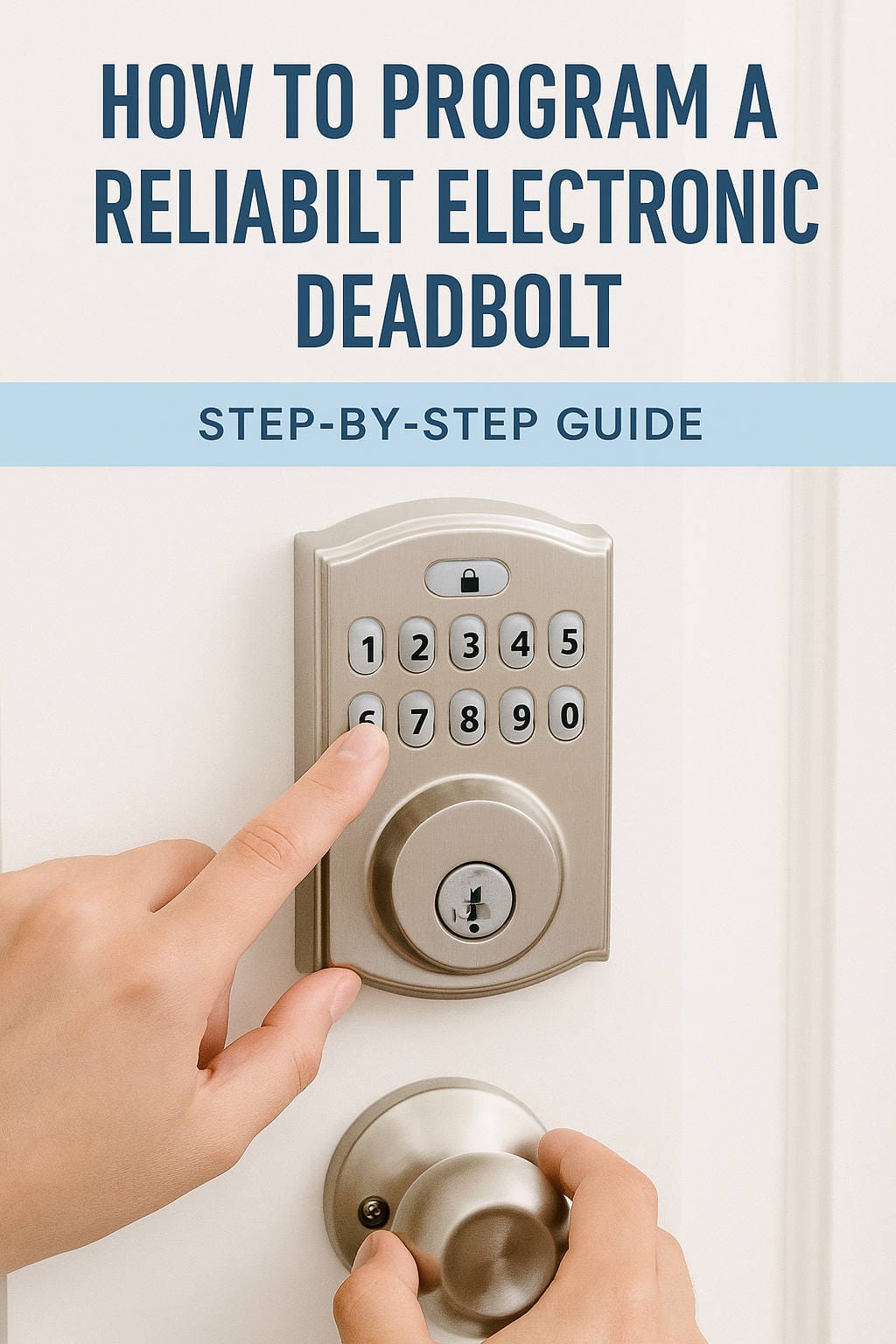If you’ve recently bought a Reliabilt electronic deadbolt or inherited one in your new home, you might be wondering how to make the most of its features. These modern locks offer enhanced security, convenience, and a cleaner aesthetic than traditional locks, but like any tech, they come with a learning curve.
In this comprehensive guide, we’ll walk you through everything you need to know about programming your Reliabilt electronic deadbolt. We’ll also help you troubleshoot common problems, keep your lock in top condition, and ensure you’re using it as securely and effectively as possible.
Understanding the Reliabilt Electronic Deadbolt
Reliabilt electronic deadbolts are well-regarded for their simplicity and affordability. Most models are standalone, battery-powered locks featuring a backlit keypad, allowing for keyless entry and multiple user codes. Some models may even be rebranded versions of locks from manufacturers like Delaney or Tru-Bolt, so the internal mechanics and programming logic are often consistent across brands.
These locks are particularly popular among homeowners, landlords, and property managers because they are easy to install and operate without requiring an internet connection or hub.
Why Use an Electronic Deadbolt?
Traditional locks are slowly giving way to electronic deadbolts for good reason:
- No keys needed: You’ll never have to worry about losing your keys again.
- Access control: Grant access to family members, guests, cleaners, or maintenance workers without handing over a physical key.
- Custom codes: Program multiple user codes for different individuals and change them easily.
- Added security: Features like auto-lock and random code entry protect against tampering and code theft.
- Ease of use: One-touch locking and illuminated keypads make everyday use seamless.
Getting Started: What You’ll Need
Before diving into programming, make sure you have the essentials:
- A fully installed Reliabilt electronic deadbolt
- Four AA alkaline batteries (lithium is not recommended)
- A screwdriver (if you need to access the battery compartment)
- The default master code (usually 123456 unless changed)
- A quiet moment to go through the setup without distraction
Make sure the lock is installed properly and the deadbolt extends and retracts smoothly when the door is open. Any misalignment will affect performance.
Step-by-Step Programming Instructions
Let’s break down the programming process in plain English so you can follow along with ease.
Changing the Master Code
The master code is the main access point to your lock’s programming settings. Change it immediately after installation to prevent unauthorized access.
- Press the program button on the interior unit (typically under the battery cover).
- Enter the current master code (default is 123456).
- Press the
LOCKbutton on the keypad. - Press
1, thenLOCKagain. - Enter your new 6-digit master code.
- Press
LOCKto confirm.
The lock should beep once and flash green. This confirms that your new master code is set.
Adding a New User Code
User codes can be 4 to 8 digits long. You can program up to 6 different codes, which is handy for families, roommates, or Airbnb guests.
- Press the program button.
- Enter your master code.
- Press
LOCK. - Press
2, thenLOCK. - Enter the new user code.
- Press
LOCKto finalize.
The green light and a single beep mean success. You can now test the new code by locking and unlocking the door.
Deleting a User Code
If someone moves out or no longer needs access, it’s wise to remove their code.
- Press the program button.
- Enter your master code and press
LOCK. - Press
3, thenLOCK. - Enter the user code you want to delete.
- Press
LOCKto confirm.
When you complete the steps correctly, you’ll hear a confirmation beep. If the lock doesn’t recognize the code, it may beep multiple times and flash red.
Enabling or Disabling Auto-Lock
Auto-lock automatically secures the door 30 seconds after it’s unlocked. It’s a great fail-safe for busy households.
- Press the program button.
- Enter your master code and press
LOCK. - Press
5, thenLOCK.
One beep means auto-lock is turned ON. Two beeps mean it’s OFF.
Factory Reset
If the lock is behaving erratically or you’ve forgotten the master code, a factory reset is the last resort.
- Remove the interior battery cover.
- Locate the reset button (usually a small black or red button).
- Press and hold the reset button for 10 seconds until the lock beeps and flashes.
This restores all settings to factory defaults, including wiping out all user and master codes.
Troubleshooting Common Issues
Even the best locks can hiccup. Here are some of the most common issues users encounter and how to resolve them.
Keypad Is Unresponsive
- Check that the batteries are fresh and properly installed.
- Remove any dirt or debris from the keypad.
- Try removing and reinserting the batteries.
Lock Doesn’t Engage or Disengage Fully
- Check door alignment and make sure the strike plate isn’t obstructing movement.
- Lubricate the latch mechanism if it feels stiff.
- Test the bolt operation with the door open to rule out friction.
Red Flashing Light or Multiple Beeps
- This usually means low battery. Replace all four AA batteries.
- If that doesn’t help, try a factory reset.
Codes Not Working
- Ensure you’re entering the full code and pressing
LOCKat the end. - Confirm the code hasn’t been deleted.
- Reset and reprogram if necessary.
Expert Tips for Long-Term Use
- Keep a backup of your master and user codes in a secure location, preferably in a password manager.
- Change codes periodically, especially for short-term rentals or if someone moves out.
- Avoid rechargeable or lithium batteries, as they can provide inconsistent voltage.
- Use auto-lock to prevent accidentally leaving the door unlocked.
- Clean the keypad occasionally to remove grime that may affect touch sensitivity.
Real-World Applications
Many homeowners install electronic deadbolts for personal convenience, but they’re especially useful in rental properties. For example, Airbnb hosts can assign unique codes to each guest and delete them after checkout, increasing both security and guest satisfaction.
Property managers appreciate how these locks reduce the need for rekeying. A few button presses can replace the whole hassle of coordinating key exchanges.
Parents love the peace of mind that comes with giving their children a secure, memorable entry code rather than a house key that might get lost.
Frequently Asked Questions
Q: What do I do if I forget the master code?
A: You’ll need to do a factory reset. There is no way to recover a lost master code without resetting the entire lock.
Q: Can I lock the door from outside without a code?
A: Yes. Just press the LOCK button on the keypad. The deadbolt will engage if the door is closed properly.
Q: How often should I change my codes?
A: For most people, every 3–6 months is sufficient. For rental properties, change them between each guest.
Q: Can the lock be used on both left- and right-hinged doors?
A: Yes. The latch can typically be flipped to accommodate either setup.
Q: Is there any smart home compatibility?
A: Most Reliabilt locks are not smart-enabled. Some newer models may offer Z-Wave or Bluetooth, so check your product manual or packaging.
Final Thoughts
The Reliabilt electronic deadbolt is an excellent choice for anyone looking to upgrade their home security without breaking the bank. Its straightforward programming, durable build, and reliable performance make it ideal for homeowners, renters, and landlords alike.
Once you’ve taken the time to set up and understand your lock, you’ll likely wonder how you ever lived without it. Just remember to maintain your codes, replace your batteries, and periodically test the functionality.
Whether you’re securing your forever home, a rental unit, or a vacation property, a properly programmed Reliabilt electronic deadbolt gives you control, convenience, and peace of mind every time you close your door.

